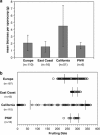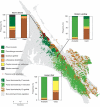Geographically structured host specificity is caused by the range expansions and host shifts of a symbiotic fungus
- PMID: 22134645
- PMCID: PMC3309363
- DOI: 10.1038/ismej.2011.155
Geographically structured host specificity is caused by the range expansions and host shifts of a symbiotic fungus
Abstract
The inability to associate with local species may constrain the spread of mutualists arriving to new habitats, but the fates of introduced, microbial mutualists are largely unknown. The deadly poisonous ectomycorrhizal fungus Amanita phalloides (the death cap) is native to Europe and introduced to the East and West Coasts of North America. By cataloging host associations across the two continents, we record dramatic changes in specificity among the three ranges. On the East Coast, where the fungus is restricted in its distribution, it associates almost exclusively with pines, which are rarely hosts of A. phalloides in its native range. In California, where the fungus is widespread and locally abundant, it associates almost exclusively with oaks, mirroring the host associations observed in Europe. The most common host of the death cap in California is the endemic coast live oak (Quercus agrifolia), and the current distribution of A. phalloides appears constrained within the distribution of Q. agrifolia. In California, host shifts to native plants are also associated with a near doubling in the resources allocated to sexual reproduction and a prolonged fruiting period; mushrooms are twice as large as they are elsewhere and mushrooms are found throughout the year. Host and niche shifts are likely to shape the continuing range expansion of A. phalloides and other ectomycorrhizal fungi introduced across the world.
Figures





References
-
- Amundson R, Austin AT, Schuur EAG, Yoo K, Matzek V, Kendall C, et al. Global patterns of the isotopic composition of soil and plant nitrogen. Global Biogeochem Cycles. 2003;17:1031.
-
- Anderson PK, Cunningham AA, Patel NG, Morales FJ, Epstein PR, Daszak P. Emerging infectious diseases of plants: pathogen pollution, climate change and agrotechnology drivers. Trends Ecol Evol. 2004;19:535–544. - PubMed
-
- Andrew C, Lilleskov EA. Productivity and community structure of ectomycorrhizal fungal sporocarps under increased atmospheric CO2 and O3. Ecol Lett. 2009;12:813–822. - PubMed
-
- Brown JL, Morales V, Summers K. Home range size and location in relation to reproductive resources in poison frogs (Dendrobatidae): a Monte Carlo approach using GIS data. Anim Behav. 2009;77:547–554.
-
- Beug MW, Shaw M, Cochran KW. Thirty-plus years of mushroom poisoning: summary of the approximately 2,000 reports in the NAMA Case registry. McIlvainea. 2006;16:47–68.
Publication types
MeSH terms
LinkOut - more resources
Full Text Sources
Molecular Biology Databases
Miscellaneous

